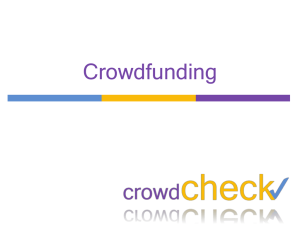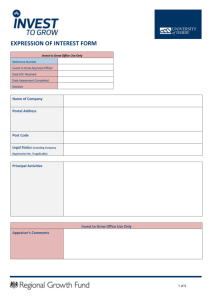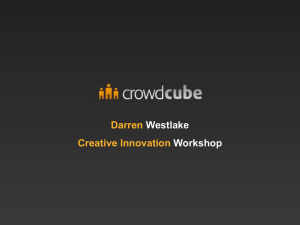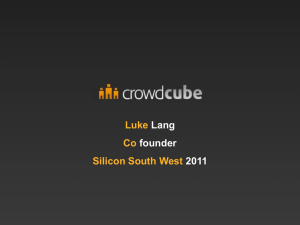Link to Power Point Presentation
advertisement
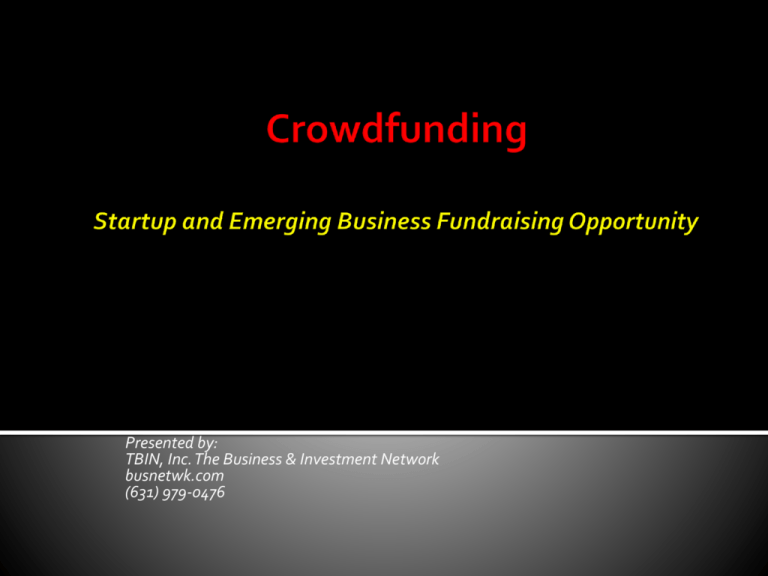
Presented by: TBIN, Inc. The Business & Investment Network busnetwk.com (631) 979-0476 1997 - A rock group raises $60,000 over the web to fund its U.S tour. 2004 - Producers use the internet to raise $50,000 to make a short science fiction film 2008 - Crowdfunding used to help victims of Hurricane Katrina 2009 - Kickstarter uses crowdfunding to raise money for business projects and ideas 2010 – Crowdfunding sites begin to raise money to pay for medical costs 2012 – The Jobs Act allows for general solicitations. Crowdfunding rules for investing are pending. The Great Recession As a result of the “great recession” of 2008 investing in startups all but dried up creating a situation called the “Valley of death” Risk aversion –most start ups will fail Time and money required to evaluate new companies The vast majority of venture capital firms decided to abandon seed capital investment and wait for the next round - usually after a company has generated some level of revenue In response, since new business account for almost all net new jobs in the U.S, Congress passed Jumpstart Our Business Startups Act on April 5, 2012. Rules regarding general investor solicitations are now law Rules regarding crowdfunding are being drafted by the SEC As such, the environment for raising early stage capital has improved. Once crowdfunding rules go into effect that environment is likely to get even better. Current sources of capital: Personal capital Loans Friends and family Grants from municipalities or educational institutions Third party Investors- general solicitation/crowdfunding Differentiate yourself by making a compelling case The basic questions that an investors will want to know: How much money are you trying to raise ? What are you going to do with the money ? How am I (the investor) going to receive an attractive return ? Answer these question in a clear and convincing way and you will increase your chance of obtaining the capital you need Would you invest in your company? Other Benefits of building a compelling case: Realize for yourself that your new product or service is not as “hot” as you thought Could be that you are too early stage whereby rewards program might make more sense Boost your confidence/ reduce your own risk/increase valuation Creates a blueprint for success – The objective is not to raise money but to build a successful business Every start up is unique Unique product or service Unique stage of development Unique ownership Unique capital needs Would you invest in your company? Building a compelling case aka: The Business Plan Key elements: Define your market Define your next step Describe your management team Understand your regulatory environment Explain the status of your Intellectual property How to deliver your product or service to market Build a financial model Explain you use of proceeds Define your potential exit strategies Valuation Defining your market Define your market niche Define the market size- domestic/global Identify key players – your competition Pin point what makes you unique What is the target percentage of the market you intend to capture Would you invest in your company? Having the right management team Researcher/ entrepreneur Business expert Advisors- other experts FDA Supply chain Manufacturing Define your next step and how you are going to accomplish it The plan for what it will take to develop our (X) to a production ready product Industrial design Commercial feasibility Rapid prototyping Production ready product (with manufacturing specifications) Here is our plan for what it will take to develop our ecommerce/ social networking site Here is our plan to bring our production ready product or service to market Would you invest in your company? Define your regulatory environment Our product or service will require Class II FDA approval It will take two years to obtain It will cost “X” dollars to accomplish Would you invest in your company ? Define the status of your intellectual property (if any) Here is the plan for what it will take to develop our patents This is the status of the patents we will obtain Here is the timeline Here is the cost My patent attorney (advisor) Would you invest in your company? Explain how you are going to deliver you product or service to market Once our product or service is ready for the market here is how we will sell it Distribution channels Social media Internet Conventional advertising ▪ Print ▪ Radio ▪ Television Advisor? Would you invest in your company? Develop your financial model Each step in the process has costs associated with them that need to be presented in a three year financial model Salaries Professional /consulting fees Overhead costs – rent, telephone , internet , office supplies Development cost Capital expenditures Marketing Building your financial model is how can you clearly define your use of proceeds It answers the questions – how much money do you need and what are you going to do with it. Would you invest in your company? Use of proceeds Clearly explain what you are going to do with the money Overhead (salaries, rent etc)- working capital Product development Intellectual property Marketing Capital cost - furniture, fixtures, computers etc Total Would you invest in your company? $ X X X X X $ XXXX Exit Strategy How and when you (the investor) are going to receive your attractive return on investment Sell or license the intellectual property you develop Sell the product or service you develop to a competitor Build an operating company that produces cash flow over time Obtain follow up rounds of financing Initial public offering (IPO) Would you invest in your company? Valuation If you obtain investment capital it will involve a valuation- how much it will cost, in terms of ownership, for the amount of money being invested. Another reason why building a compelling case is so important Highly subjective : Stage of development Amount of money being invested Overall market potential Amount of risk involved Timeline on exit strategy Comfort level Would you invest in your company? Questions ? This presentation is available on our website busnetwk.com Dan Bartley TBIN, Inc. busnetwk.com dbartley@busnetwk.com (631) 979-0476




